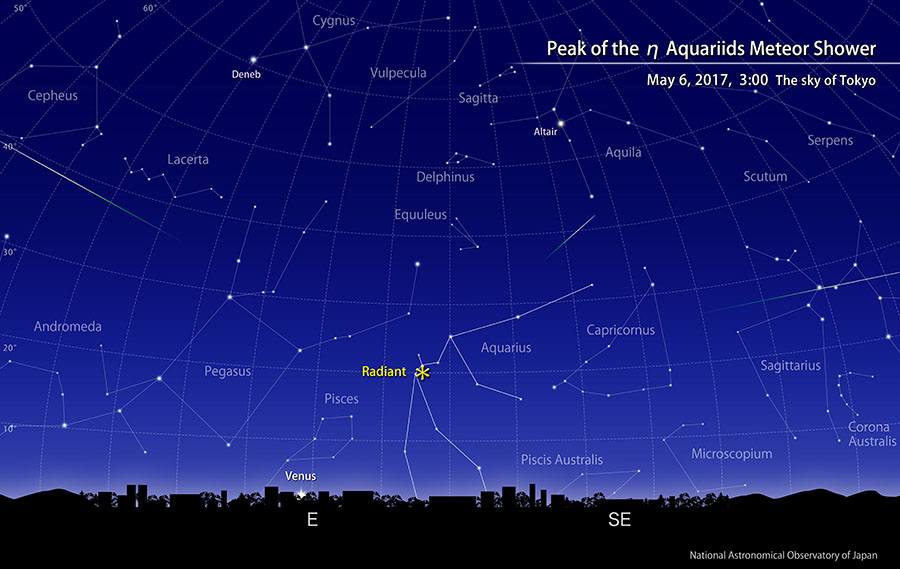Peak of the η(Eta) Aquariid Meteor Shower (May, 2017)

Let’s Look for Shooting Stars in the Dawn
Around May 6, the η(Eta) Aquariid meteor shower is predicted to reach its peak.
What kind of meteor shower is the η Aquariid meteor shower?
More than 100 meteor showers appear during the year. Among them, “the Quadrantid meteor shower” in January, “the Perseid meteor shower” in August, and “the Geminid meteor shower” in December are meteor showers known to have many meteors every year. These are called “the 3 Major Meteor Showers.” Actually after “the 3 Major Meteor Showers,” the η Aquariid meteor shower is the next largest scale of meteor showers that appear steadily every year.
But, in mid to high latitude areas in the northern hemisphere, such as Japan, the radiant point (note 1) of the η Aquariids doesn’t rise very high. The lower the altitude of the radiant point is, the lower the number of the meteors that can be seen is. So, the η Aquariids don’t receive much attention in Japan.
This year, for two to three days before and after the η Aquariids’ peak activity, during the time from when the Moon sets after midnight until the sky starts to get light, you can observe the meteors under good conditions without interference from the moonlight. The Moon sets earlier on the nights before the peak, so the favorable observing time lasts longer. If you observe under a night sky dark enough to see the Milky Way, you may be able to see about 5 meteors in an hour.
Although the number of meteors is not so many, since the altitude of the radiant point is low, remarkable meteors with long trails sometimes appear (note 2). How about waking up early and wishing for such beautiful meteors to appear?
While observing them, choose a place where there is no light nearby and you can see a wide portion of the sky. You don’t have to worry about which direction to watch. Don’t use telescopes or binoculars. Observing with the naked eye is best. Although it's getting warmer, it is still very cold before dawn in Japan. Please wear warm clothes and make sure to protect yourself against cold weather.
(note 1) “Radiant point” is the point the meteors of the meteor shower seem to appear radially around.Back
(note 2) Many meteors that appear at positions far from the radiant point have long trails.Back
Reference: Ephemeris Computation Office
You can look up the rising and setting times for the Sun and the Moon, and the phases of the Moon in the “Koyomi Station” of the NAOJ Ephemeris Computation Office. You can find the appearance of the Moon and planets as seen from a typical city under “Sky Viewer.”